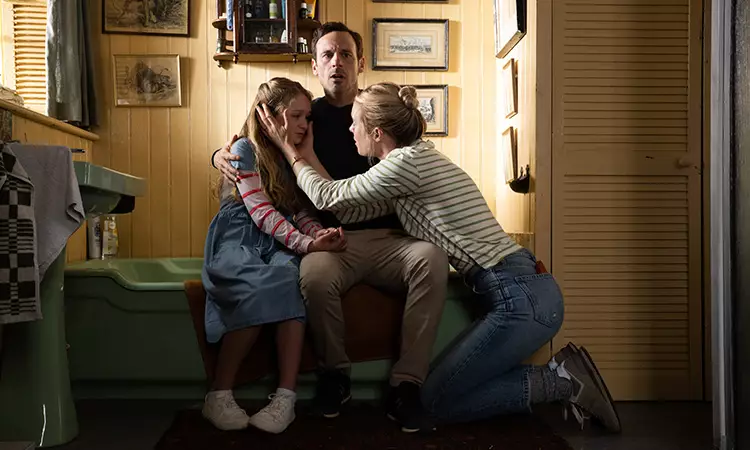The realm of horror cinema often pushes the boundaries of societal norms, forcing audiences to confront their fears, insecurities, and discomforts. With its latest offering, “Speak No Evil,” Blumhouse Productions dives into the psychological nuances of polite society, unraveling the psychological tension between characters entangled in an intricate web of social discomfort. Actor Scoot McNairy, who portrays Ben, captivates viewers by pointing out how the film masterfully explores a distinct psychological landscape rather than adhering to the conventional horror film format.
Unraveling Awkwardness
In “Speak No Evil,” the narrative commences as a pleasant getaway for the American family of Ben, Louise, and their daughter Agnes. They are invited to the picturesque estate of a British family and initially assume that they have formed new bonds. However, the film quickly deviates from a light-hearted holiday tale into a gripping psychological horror, where the ordinary morphs into the abnormal. McNairy vividly depicts this sentiment: “It’s more like The Office than it is a horror movie!” He emphasizes that the tension arising from social interactions is the heart of the narrative, keeping viewers on the edge of their seats as they grapple with the emotional discomfort thrust upon them.
Indeed, director James Watkins crafts an atmosphere that simmers with tension, allowing audiences to ponder the unspoken anxieties that often reside beneath social niceties. Mackenzie Davis, who plays Louise, further elucidates this psychological dance, revealing that the sheer discomfort witnessed throughout the storyline serves as a precursor to the film’s darker moments.
Exploring Social Constructs
As the story unfolds, deeper themes of class conflict, manipulation, and gender roles begin to emerge. McNairy points to the discussion surrounding toxic masculinity, particularly manifested in the interaction between his character, Ben, and Paddy, the seemingly sociable ‘alpha male’ played by James McAvoy. The film complicates simple archetypes by showcasing a spectrum of masculinity that invites scrutiny. “That being said, James McAvoy is not a toxic masculine person at all,” McNairy candidly shares, hinting at the film’s nuanced portrayal of complex characters who contradict typical labels.
The unsettling dynamics between Ben and Paddy create a palpable tension that offers a critique of masculinity within societal frameworks. This exploration provides viewers a deeper understanding of how societal constructs can inform personal relationships, fostering conflict and discomfort. McNairy’s insistence on depicting these themes as reflections of a broader societal issue amplifies the film’s psychological undercurrents.
Layered within the film’s chilling premise is an intimate examination of Ben and Louise’s fracturing relationship. Their journey is not merely about surviving a weekend gone wrong; it serves as a narrative device to highlight their struggles, making their predicament all the more harrowing. Davis notes that their decision to reconnect with Paddy and Ciara stems from a state of crisis—“We meet the couple of Ben and Louise in a crisis moment in their relationship,” she explains. The couple is portrayed undergoing therapy while grappling with the need for compromise, amplifying the tension as they face external pressures that threaten to unravel their union.
Louise’s choices resonate with anyone who has ever compromised for the sake of maintaining a relationship. The tension stemming from her desire to salvage her marriage renders their interactions increasingly uneasy and noteworthy. The nuances of this exploration add depth to the psychological horror, transforming it from mere jump scares to a resonant reflection on human vulnerability.
The film subtly critiques societal norms, exploring deeply ingrained fears that reside within the psyche. McNairy articulates this sentiment, suggesting that contemporary horror is shifting from external threats to introspective horrors, an evolution that mirrors the societal anxieties of today. “I think within social media and the digital world we live in, a lot of that fear now that we have is internalised,” he suggests, inviting audiences to confront their own fears that manifest through societal expectations.
Davis reiterates this thought, arguing that typical horror movie structures grant filmmakers room to layer in significant thematic content that might otherwise be deemed too provocative for a conventional drama. In this way, “Speak No Evil” seeks to stimulate both the mind and the nervous system, intertwining elements of entertainment with more profound societal critiques.
As the credits roll, McNairy hopes audiences walk away feeling “scared out of their minds.” The film’s unsettling ability to weave social discomfort into a chilling narrative speaks to the contemporary human experience, where fear can often stem from our interactions and expectations within society. “Speak No Evil” thus transcends the confines of a predictable horror film, offering a thought-provoking exploration of the darker sides of human nature lurking beneath the surface of civility.


Leave a Reply